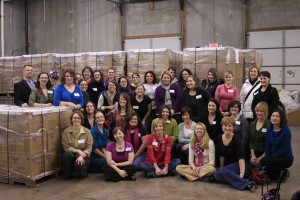Tag: haiti’
Be Thankful for Clean Water
- by KitchenPantryScientist
This Thanksgiving, here is what I’m thankful for:
A nasty stomach virus burned through our house this week (I blame a communal bowl of popcorn.) Following the kids around, I cleaned up after them with disinfectant wipes and lots of soap and water. If I didn’t hear the comforting swoosh of the faucet following the sound of a flush, I’d yell “wash your hands!” When they emerged from the bathroom, I’d hand them a glass of water or bottle of sports drink to sip so they could replace the fluids they’d lost.
In Haiti, for most people there are no clean toilets and there is no clean water for hand washing. There often isn’t clean drinking water and ditches are filled with sewage. Over 1,000 people have already died in a recent cholera epidemic and countless more are infected. Cholera is a disease of people living with poor sanitation.
What can you do to help?
Click the link above to donate a day of clean water to someone in the third world. Here’s what P&G is doing now to help with the cholera epidemic in Haiti. You can click once a day!
According to the World Health Organization, waterborne diseases remain the leading cause of illness and death in the developing world. Every 20 seconds, a child in a developing country dies of a water-related illness. Bacterial diseases caused by E.coli and Vibrio Cholerea, parasites like Guinea Worm, viruses and protozoa are all carried by unclean water. Some of these potentially deadly organisms can be killed by boiling, but for many people in the world, firewood is scarce.
We don’t know how lucky we are. Be thankful for your clean drinking water, even if it tastes like chlorine. Be thankful for your toilet.
Happy Thanksgiving and don’t forget to wash your hands!
Many aid organizations and churches have programs to help people get access to clean water and proper sanitation, whether it’s by helping dig wells or sending bars of soap. WaterAid is a U.K.-based international non-profit organization that is helping bring not only clean water, but sanitation and hygiene programs to many villages desperate for clean water. The organization makes local women an integral part of the process. Proctor and Gamble, who is running the Clean Water Blogivation campaign, make a PUR powder which can be mixed with contaminated water to make it safe to drink. They have a Children’s Safe Drinking Water program and have been working with a number of organizations to distribute the PUR powder around the world to those who don’t have access to clean water.
There’s a fairly comprehensive list of water-born microbes on Wikipedia, and if you’d like to learn more, the World Health Organization and the Center for Disease Control are great resources.
Cholera- A Pretty Name for an Ugly Disease
- by KitchenPantryScientist

Vibrio cholerae bacteria
Picture yourself lying on a dirty cot with a hole cut out under you to collect buckets full of unstoppable diarrhea. Now imagine your child lying there. Finally, pretend you are not one of the lucky ones lying on a cholera cot in a hospital, but are lined up outside in the street, waiting for help.
Cholera is an ugly disease.
The bacteria Vibrio cholerae makes a toxin that shreds the intestinal lining, causing white flecks that look like rice to be passed in huge volumes of watery diarrhea. In hospitals, these “rice water stools” are collected and measured in buckets so body fluids can be replaced. Adults can lose up to 22 liters a day while battling this devastating infection. Without fluid and electrolyte replacement, most victims die from shock.
Lucky patients that recover often still carry the bacteria and can infect others. They can even re-infect themselves.
Cholera bacteria can survive outside the human body in water. They do especially well in dirty water. Unsanitary conditions are breeding grounds for Vibrio cholerae.
I read this morning in the New York Times that cholera has spread from the Hatian countryside to the crowded, unsanitary camps of the earthquake survivors in Port-au-Prince. The camps don’t have clean toilets and are often flooded when it rains. Over a million people live in filth and poverty. According to the article, health officials predict that over 270,000 people could get sick with cholera over the next few years.
People like you, and me, and our kids.
What can you do to help? Support aid organizations that are mobilizing to get clean water, water purification supplies, and medical supplies to Haiti. Once the supplies arrive though, it’s up to the Hatian government to make sure workers are able to get them to the people most in need. Let’s hope they do.
Hungry or Starving?
- by KitchenPantryScientist
Last night, as 39 of my fellow Minnesota bloggers and I gathered to pack food for “Feed My Starving Children” , we were asked the question, “what is the difference between hungry and starving?” The dictionary defines hunger as experiencing a desire or need for food, while starving is defined as: to suffer or die from extreme or prolonged lack of food. In fact, when you are starving, your body actually begins metabolizing, or eating itself. If you don’t get food, you will die. The only way to reverse the process is to give a starving body nutrients with which to rebuild itself.

We mixed together soybeans, chicken-flavored vitamins, vegetables and rice in small plastic bags to be sent to another country, possibly Haiti, to feed starving people. People like us. Children like our children. Together, in less than an hour, our group, along with three or four others, packed 13,824 meals: enough food to feed 38 people for a year. It is astonishing that so little effort can change, and possibly even save, so many lives. To learn more about Feed My Starving Children and how you can help, visit their website.
